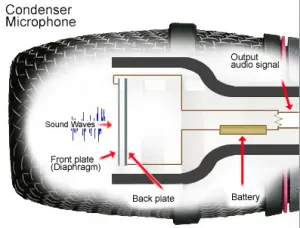One Listener asked “What does the word “condenser” in condenser microphones mean?”
Another form of this question that often comes up is “what is the difference between condenser and dynamic microphones?” Since I chatted with Scott Roche about his CAD GXL2200 Cardioid Condenser Microphone, I’ll address what a condenser is this week and then the dynamic the next.
The terms dynamic and condenser really refer to the method in which the microphone generates an electrical signal. How it takes your sound wave and converts it into a signal.

In a condenser mic, the diaphragm is a very thin plastic film (see diagram above), coated on one side with gold or nickel, and mounted very close to a conductive stationary back plate (again see diagram above). A voltage is applied to the diaphragm by an external power supply (battery or phantom power). The diaphragm and back plate, separated by a small volume of air, form an electrical component called a capacitor (or condenser). The capacitance, or space between these two plates, varies as the freely suspended diaphragm is displaced by the sound wave. As it does so, the electrical charge that it induces in the back plate changes proportionally. The fluctuating voltage on the back plate is therefore an electrical representation of the diaphragm motion.
Because the diaphragm of the condenser is not loaded down with the mass of a coil like the dynamic microphone is, it can respond very quickly to transients, which are the sounds at the beginning of the sound wave form. Many podcasters like condensers because of the authentic sound they provide. (Thanks to Crown for portions of this write up.)